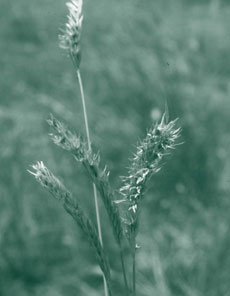
Astrebla pectinata (Barley Mitchell grass)
Description

Astrebla pectinata is a warm season perennial grass, which is palatable to livestock even when it is dry. Crude protein levels range from 4.7–10.8 % and phosphorus 0.21–0.43 %. Mitchell grass provides one of the most stable and economically important pastures in the semi-arid areas of eastern Australia. There are four species of Mitchell grass in Australia with A. pectinata being found in the drier regions. It is an erect plant with pale coloured seed heads positioned generally above the leaves. 'Turanti' is a variety of this species bred by NSW Agriculture. This variety has been selected for high seed yield, superior dry matter and leaf production as well as increased proportion of green leaf growth in winter.
Morphology
Vegetatively similar to A. lappacea (Curly Mitchell grass), however, this species tends to more erect with a more compact base. It produces less seed heads than A. lappacea and also tends to be less variable in growth habit and inflorescence (Inflorescence - a group of flowers borne on a stem) characteristics. A. pectinata can grow up to 1 m in height. The stems are erect, hairless, smooth and usually branched. The seed head is born above the leaves, unbranched, 3–8 cm long, 1–1.5 cm wide. The head appears light in colour and viewed from behind has 2 distinct rows of spikelets (Spikelet - consists of one or more florets and is the basic unit of the inflorescence in grasses) on either side of an axis somewhat resembling barley.
Distribution
A. pectinata occurs in similar areas to that of A. lappacea but also extends into the drier areas (<250 mm rainfall). It occurs in areas from the south western regions of New South Wales, throughout south western Queensland, through central Australia to the Kimberley region of Western Australia. A. pectinata tends not to dominate a pasture in contrast to A. lappacea. A. pectinata will do well on both grey cracking clay soils and lighter red soils.
Vegetation associations
Associated with curly Mitchell grass (A.lappacea) and Queensland bluegrass (Dichanthium sericeum).
Sowing
Ideal conditions
Maximum germination percentages (>80%) can be achieved at temperatures between 20–40°C. Ideal sowing times are September/October or January/February avoiding the hottest part of summer when the soil surface dries out quickly. Astrebla spp. has a high water requirement and therefore it is best to sow when the soil moisture profile is close to full. Conventional seed bed preparation techniques for a cereal crop will apply to paddock preparation for Astrebla spp. Good rainfall or irrigation post sowing will assist in successful field establishment.
Methods
Naked and fluffy seed can be sown using conventional machinery. Buffel drum seeders have also been successfully used to sow fluffy seed. Seed can be broadcast into a weed free seedbed or into wheat stubble. Aerial seeding has also had some success. A light harrowing after broadcasting or aerial application will assist in achieving good soil/seed contact. For seed production under irrigation, sowing rates greater than 8 kg/ha are recommended, for dryland pastures 1–2 kg/ha. Seed is sown shallow, no more than 1 cm deep. Ideal sowing times are early or late summer.
Weed control
Seedlings appear to have little tolerance to Atradex® and Glean® . For advice on herbicide recommendations contact your local agronomist.
Management
A specialised root system found on mature plants allows this species to persist through droughts and under heavy grazing. Whilst this species is long-lived, recruitment of new seedlings occurs only infrequently. Astrebla spp. responds well to moderate grazing or cutting which tends to stimulate tillering (Tiller - aerial shoot usually lateral and basal and more or less erect) and seed production. As this species ages both the number and size of inflorescences are reduced, however, cutting and irrigation may help to promote new growth. A. pectinata is susceptible to frost and floods.
Other species
- Astrebla lappacea (Curly Mitchell grass)
- Austrodanthonia bipartita (Wallaby grass)
- Austrodanthonia caespitosa (White top)
- Austrodanthonia richardsonii (Wallaby grass)
- Bothriochloa macra (Red grass)
- Chloris truncata (Windmill grass)
- Dichanthium sericeum (Queensland bluegrass)
- Elymus scaber (Common wheat grass)
- Heteropogon contortus (Black speargrass)
- Microlaena stipoides (Microlaena or Weeping grass)
- Paspalidium constrictum (Box grass)
- Paspalidium jubiflorum (Warrego summer grass)
- Themeda triandra (Kangaroo grass)

